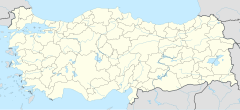Zilkale
| Zilkale | |
|---|---|
 Ramparts of Zilkale | |
| General information | |
| Type | Castle |
| Location | Fırtına Valley |
| Town or city | Çamlıhemşin, Rize Province |
| Country | Turkey |
| Coordinates | 40°55′42″N 40°57′17″E / 40.92830°N 40.95463°E |
| Elevation | 1,130 m (3,710 ft) |
| Completed | 14th-15th century |
Zilkale is a medieval castle located in the Fırtına Valley (literally "Storm Valley"), and is one of the most important historical structures in Çamlıhemşin district of Rize Province in the Black Sea Region of Turkey.[1]
The castle is built at an altitude of 1,130 m (3,710 ft), and sits at the edge of a cliff overlooking the Fırtına River (Turkish: Fırtına Deresi approximately 380 m (1,250 ft) below running at an elevation of 750 m (2,460 ft) southeast of it.
It is believed that the castle was built between the 14th and 15th centuries. The castle consists of outer walls, middle walls and the inner castle.[2] There are garrison quarters, and a possible chapel and head tower. According to Anthony Bryer, it is an Armenian chapel and built by the Empire of Trebizond for the local Lord of Hamshenis.[3]
Etymology
Zilkale: Zil means "bell" and kale means "castle" in Turkish (Zilkale = "Bell Castle").[4]
Alternatively:
Zilkale: Zir means "lower" in Persian and kale means "castle" in Turkish.[5]
Notes
- ^ Özhan Öztürk. Karadeniz. Istanbul. 2005 pp. 1209-10
- ^ It was built on the western skirts of Fırtına Creek, 15 km (9.3 mi) south of the torn center
- ^ Bryer, Anthony; Winfield, David (1985). Byzantine Monuments and Topography of the Pontos. Dumbarton Oaks Centre Studies. Vol. 2. Dumbarton Oaks Research Library and Collection. p. 348. ISBN 978-1597403177.
- ^ BRYER A. & WINFIELD D. (1985), Byzantine Monuments and Topography of the Pontos. Dumbarton Oaks Center Studies. 2 vol. Washington.
- ^ Öztürk, Ö. Karadeniz. p. 1210
External links
- All about the region
- Zilkale pics
- HQ Zilkale image
- About Region (in Turkish)


